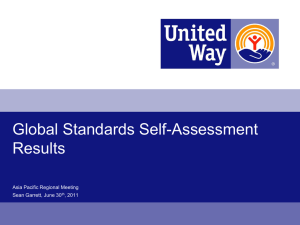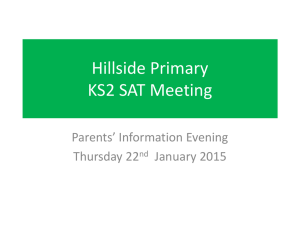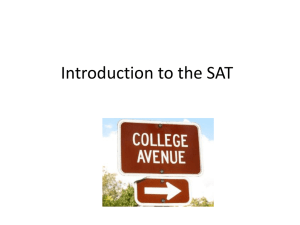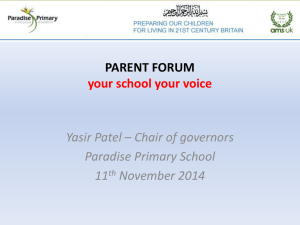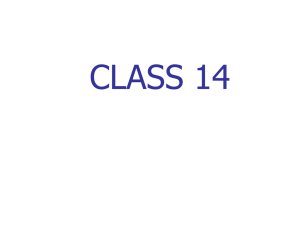KS1-SATs-mtg - Middleton Parish CE Primary School
advertisement
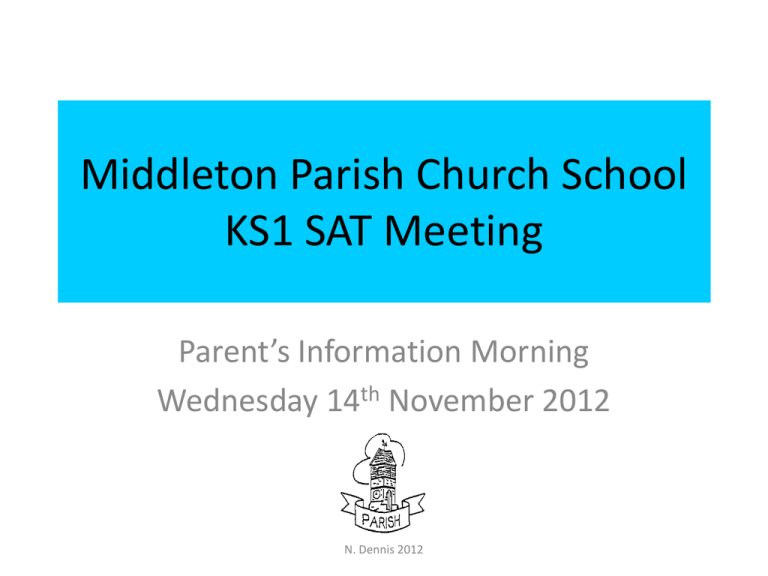
Middleton Parish Church School KS1 SAT Meeting Parent’s Information Morning Wednesday 14th November 2012 N. Dennis 2012 Working together for success We believe every child is: Special Valued Unique Able to succeed Working together for success At school we have: High expectations Targeted support Working together for success Our aim is for children to feel: Happy Challenged Supported Confident Secure Valued Successful Working together for success Children Home School What are SAT Tests and Why do children have to take them? • KS1 SAT papers are taken by pupils in year 2 (when they are 67 years old) as part of the National Curriculum assessment programme. • KS1 SAT results are used by KS2 to teach children at an appropriate level. They will also use these results to predict their levels at the end of KS2. • Children take KS1 SAT papers in two core subjects: English and Maths. These are broken down into 5 separate examined tests; 5 all marked internally. N.Dennis 2012 • The SAT papers are used to confirm teacher assessment. • Some children will also take a level 3 SAT paper. This is for children who are already consistently working above a level 2 in class. N Dennis 2012 What are SAT Levels? Level 1: Below the nationally expected level of attainment for a pupil at the end of Year 2. Level 2b: The nationally expected level of attainment for a pupil at the end of Year 2. Level 3: Above the nationally expected level of attainment for a pupil at the end of Year 2. At school, we also use sub-levels as a, b or c (a being the highest). Eg. A level 2c is a low level 2, a 2b is a secure level 2 and a 2a is a high level 2. N.Dennis 2012 What’s the Difference between Attainment and Progress? Progress •At the end of FS, Reception, your child will have a FS profile. These results then enabled school to predict individual children’s progress by the end of year 2. Roughly speaking, a child in Reception achieved Scale Point 6 = Year 2 predicted Level 2b. Attainment •This is the expectation for a child's SAT performance according to their age. For example, an 7 year old child is expected to achieve level 2b by the end of year 2. A child achieving level 3 is working at a high level. N.Dennis 2012 How Many Tests Are There? English Reading: • The Level 2 KS1 Reading SAT Paper. It is in 2 parts: a fiction and non fiction section. Children read a short passage of text and then answer questions based on the text they have just read. There are different types of questions, some are multiple choice, some need a written answer and others require matching statements. Pupils can refer back to the text at any point. • The Level 3 SAT Reading Paper is essentially just another reading comprehension assessment but at a higher level. Pupils are given a Reading Booklet again with 2 parts: fiction and non fiction. Pupils read whole text and then a further answer the questions based on the text. As with the Level 2 Reading Test, the Level 3 Reading Test has multiple choice, questions which need a written answer and others require matching statements. The Level 3 paper requires more in depth responses to demonstrate greater understanding and inference. N. Dennis 2012 English Written: • Pupils complete 2 writing tasks and a spelling test. • The writing genres have been covered in our normal classwork. The tasks provide an opportunity for the children to show what they are capable of. • The spelling test is 20 words, some phonic based and some tricky words. • The scores from the 2 written tasks, the spelling and a handwriting mark are added together to give an overall level. • This is used along with day to day classwork to produce a final level. N.Dennis 2012 Mathematics Papers: • The Level 2 Mathematics SAT paper has 5 mental questions to begin with and then about 20 further written questions. • Children can use tens and units apparatus and hundred squares if they need the support. • The score at the end gives the level. • As with the reading, some children will complete the Level 3 Mathematics SAT paper. The Level 3 Mathematics test follows the same format as the level 2, with 5 mental questions to begin and then around 20 written questions. The score at the end gives the level. • • As with the English, this level is taken alongside day to day class work to produce a final level. N.Dennis 2012 Teacher Assessment of Writing Three strands are assessed through the writing tests: • Sentence structure and punctuation • Text structure and organisation • Composition and effect. The composition and effect strand carries the largest number of available marks and is the main focus for this particular test. Local Authority moderators ensure high standards of Teacher Assessment. N.Dennis 2012 SAT Timetable The KS1 SATs will take part in May, before half term. They are completed during normal day to day activities. The children are used to completing these papers and should feel no extra pressure or stress. Some will not even know they have taken them! N.Dennis 2012 How You Can Support Your Child At Home: • • • • Sensible bedtime. Healthy diet – eat breakfast. Drink plenty of water at home and school. Encourage your child positively, without putting too much pressure on him/her. • Ask your child about what they have done in school. • Read with your child, discussing the content and choice of words the author has made. Ask your child questions about their reading, encouraging them to identify words or phrases to back up their answers. • Help your child to learn maths facts. N.Dennis 2012
